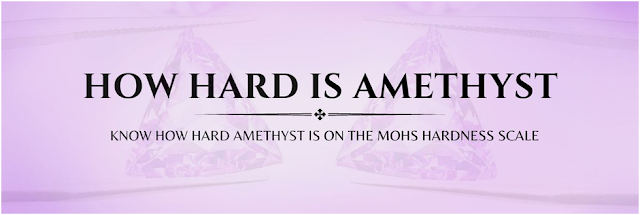HOW HARD IS AMETHYST? THE DETAILS YOU NEED TO KNOW
Amethyst is a popular gemstone known for its beautiful purple hue, but have you ever wondered how hard it is? The hardness of a gemstone is an important factor to consider when wearing or purchasing jewelry. Knowing the hardness of amethyst can help you determine how best to care for your pieces. In this blog post, we'll explore how hard amethyst is on the Mohs hardness scale and other details you need to know about the gemstone.
MOHS SCALE
OF MINERAL HARDNESS
The Mohs scale of mineral hardness is a qualitative scale that was created by German geologist and mineralogist Friedrich Mohs in 1822. The scale rates the hardness of minerals on a scale from 1 to 10, with 1 being the softest and 10 being the hardest. The scale is based on the ability of a harder material to scratch a softer material. For example, if material A can scratch material B, then material A is harder than material B.
The scale has become an invaluable tool for geologists, jewelers, and anyone else who needs to identify the hardness of different materials. It is widely used in industry and academia for measuring the relative hardness of different substances.
Some of the minerals used to measure the hardness on the Mohs Scale include talc (1), gypsum (2), calcite (3), fluorite (4), apatite (5), Feldspar (6), quartz (7), topaz (8), corundum (9), and diamond (10). Each mineral is compared against the other minerals on the scale, which makes it possible to determine the hardness of a substance.
WHAT IS
AMETHYST?
Amethyst is a stunning purple gemstone that has been used throughout history for its ornamental value and metaphysical properties. It is the birthstone for February and is also the stone associated with the 6th wedding anniversary. Amethyst is a variety of quartz and is part of the mineral family known as silicates. It is the most popular form of quartz and can be found in a wide range of colors from light lilac to deep royal purple.
Amethyst's rich color comes from iron and aluminum impurities present in quartz crystals. It has been prized since ancient times for its unique hue and is said to have been a favorite of kings, queens, and other nobility. The name “amethyst” derives from the Greek word “amethustos,” meaning “not intoxicated,” in reference to its legendary power to protect against drunkenness. Amethyst gemstone beads are still believed by some to have healing powers that promote balance, protection, and inner strength.
The hardness of amethyst on the Mohs scale of mineral hardness is 7. This makes it suitable for use in jewelry, as it is quite durable. In fact, amethyst beads have long been used in jewelry and other decorative items due to their captivating color and ability to take a high polish. Its vibrant hues are also used in making religious items such as rosaries and crucifixes.
No matter how you use it, amethyst is an exquisite gemstone that adds beauty and elegance to any setting.
Amethyst's hardness also contributes to its popularity in the gemstone market. Since it is more durable than other wholesale gemstones, it is less likely to get scratched or chipped over time. This means that amethyst jewelry can last for generations with proper care and maintenance.
The combination of beauty, durability, and affordability makes amethyst, a popular choice for many jewelry wearers. Its hardness allows the wearer to confidently enjoy their amethyst jewelry without the worry of wear and tear. Whether you’re looking for a ring, necklace, or any other piece of jewelry, amethyst is an excellent choice.
CONCLUSION
Amethyst is a beautiful and popular gemstone, known for its stunning purple hue. While it is softer than many other faceted gemstones, it is still quite durable and long-lasting. Amethyst has a Mohs scale rating of 7, making it one of the harder loose gemstones on the scale. While this may not make it the hardest material around, it does make it an ideal choice for many jewelry applications. If you're looking for vibrant gemstones or stunning wholesale gemstone beads that can stand up to everyday wear and tear, amethyst is definitely worth considering.




Comments
Post a Comment